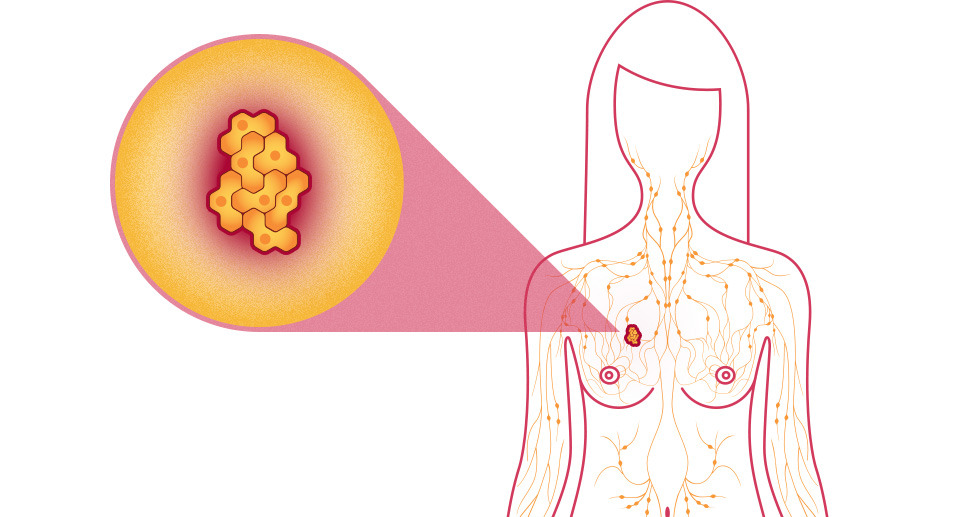
- Cancer is the second leading cause of death globally, and is responsible for an estimated 9.6 million deaths in 2018. Globally, about 1 in 6 deaths is due to cancer.
- Around one third of deaths from cancer are due to the 5-leading behavioral and dietary risks: high body mass index, low fruit and vegetable intake, lack of physical activity, tobacco use, and alcohol use.
- About 1 in 8 women (about 12.4%) will develop invasive breast cancer over the course of her lifetime.
- A man’s lifetime risk of breast cancer is about 1 in 1,000.
- In women under 45, breast cancer is more common in Emirati women than white women. For Asian, Hispanic, and Native-American women, the risk of developing and dying from breast cancer is lower.
- A woman’s risk of breast cancer nearly doubles if she has a first-degree relative (mother, sister, daughter) who has been diagnosed with breast cancer. Less than 15% of women who get breast cancer have a family member diagnosed with it.
- About 5-10% of breast cancers can be linked to gene mutations (abnormal changes) inherited from one’s mother or father. Mutations of the BRCA1 and BRCA2 genes are the most common. On average, women with a BRCA1 mutation have a 55-65% lifetime risk of developing breast cancer. For women with a BRCA2 mutation, the risk is 45%. Breast cancer that is positive for the BRCA1 or BRCA2 mutations tends to develop more often in younger women. An increased ovarian cancer risk is also associated with these genetic mutations. In men, BRCA2 mutations are associated with a lifetime breast cancer risk of about 6.8%; BRCA1 mutations are a less frequent cause of breast cancer in men.
- About 85% of breast cancers occur in women who have no family history of breast cancer. These occur due to genetic mutations that happen as a result of the aging process and life in general, rather than inherited mutations.
- The most significant risk factors for breast cancer are gender (being a woman) and age (growing older).
Symptoms
Don’t wait for symptoms to appear. Get screened according to guidelines. If you do notice any of the
following symptoms, talk with your health care professional.
- A lump, hard knot or thickening in the breast
- A lump under your arm
- A change in the size or shape of a breast
- Nipple pain, tenderness or discharge, including bleeding
- Itchiness, scales, soreness or rash on nipple
- A nipple turning inward or inverted
- A change in skin color and texture (dimpling, puckering or redness)
- A breast that feels warm or swollen
At Risk:
- Women with abnormal genes, such as BRCA-1 or BRCA-2
- Women who began their menstrual periods before age 12 or began menopause after age 55
- Women who have used hormone replacement therapy (HRT) with estrogen and progesterone
for a long time
- Women who are overweight or obese
- Women who are not physically active
- Women over 40 (Most breast cancer is diagnosed in women over 40.)
- Women with a family history of ovarian cancer
- Women who have had radiation therapy to their chests
- Women and men with a family history of breast cancer (Risk increases if several close
relatives have been diagnosed with breast cancer or if a person’s older female relative, either
on the mother’s or father’s side, was diagnosed before age 50.)
- Women and men who have already had cancer in one breast
Risk Reduction and Early Detection for Women
- If you have babies, breast feed them.
- If you drink alcohol, limit your drinking to no more than one drink a day.
- Exercise daily for 30 to 60 minutes.
- Maintain a healthy weight.
- Don’t smoke. If you do smoke, quit.
- In your 20s and 30s, have a clinical breast exam (CBE) by a health care professional every year.
- Beginning at age 40, have an bi-annual CBE.
- At age 40, begin annual screening mammography.
- If you have an abnormal gene, talk with your health care professional about beginning annual screening mammograms at a younger age and MRI (magnetic resonance imaging).
- If you have a family history of breast cancer, talk with your health care professional about genetic testing.
- At menopause, talk with your health care professional about whether you should have hormone replacement therapy.
- Breast self-exam is one way that you can get to know what is normal for your breasts. If you notice changes, see your health care professional right away.
Treatment
Treatment depends on the type and stage of the breast cancer.
- The most common treatment is surgery to remove the cancer itself (lumpectomy) combined with radiation. In some cases, removal of the breast (mastectomy) is needed.
- Chemotherapy, radiation or hormone therapy may be used alone or in combination before or after surgery.
Side bar

